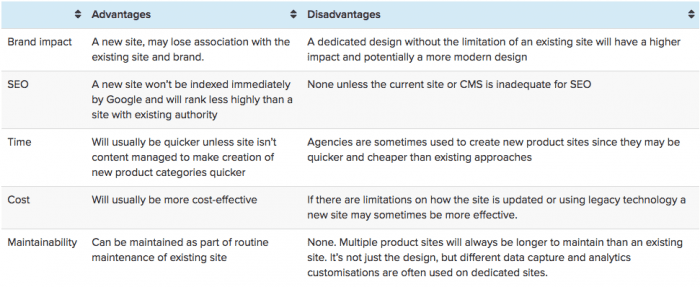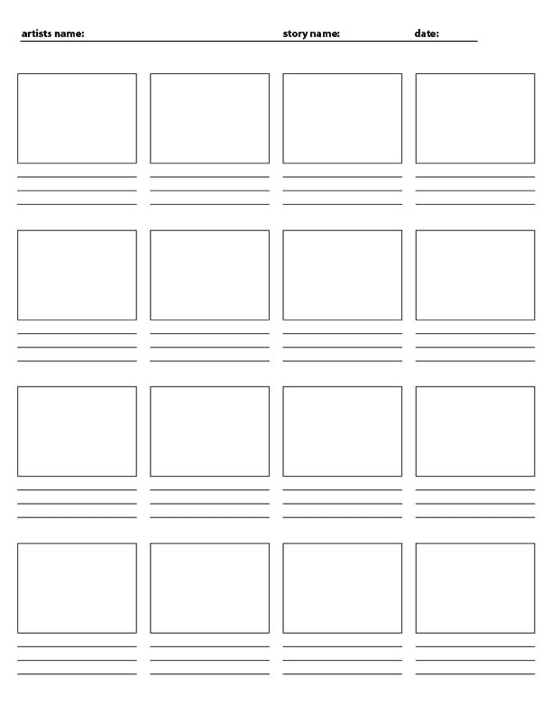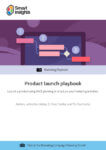Should you create a separate site and which content do you need?
In our experience, you should think carefully before creating a new product launch or campaign site if you have already got a company website.
You may already have your own website that incorporates essential company information. In this case, you have the decision of whether to create a dedicated site or integrate it into your existing site.
Download Premium Resource – Product launch playbook
Launch a product using RACE planning to structure your marketing activities. A marketing playbook defines the key messages, types of communications, best practices and optimisation techniques that should be used to maximise return-on-investment for different marketing objectives.
Access the Product launch playbook
In most cases, using an existing site will be most cost-effective and a well-designed existing site will have the flexibility to create the impact you need.
Advantages of using an existing site for your new product launch

A product-specific website focuses on just one thing: your amazing new offering. The best product-specific sites are simple and to the point. Whatever your budget, the golden rule is ‘less is more’. The easier a site is to navigate, the greater the chance of securing interest - as well as orders.

If money is tight and you cannot afford a website design company, you could opt for one of many off-the-shelf DIY website building platforms. Companies such as Squarespace, Wix and GoDaddy provide highly creative adaptable alternatives to longer-established players like WordPress. For many, the platforms provide enough tools to get a website up and live quite quickly. A good idea is to hire a designer with the graphics skills to turn raw content into a slick site.
Compelling content is everything. The more professionally produced the content, the better. Invest in having your product professionally photographed. Wherever possible incorporate 360° interactive views of your product. Think about the mood you are trying to convey into your site – and brief the photographer accordingly.
Study competitive videos before briefing a filmmaker to produce yours. Just as you would storyboard your video, so you should storyboard your entire site. Remember, less is more.
Increasingly people scan rather than read. So, unless you are writing an insights piece, for example, a blog, keep copy on your site to a minimum. Instead, concentrate on images.
Typical new product launch site elements:
- Video top banner featuring a carrousel of clips (five seconds per clip) which reflect your new product brand personality.
- Product shot – with an option to view the product in 360°.
- Shop section featuring labelled photographs highlighting specific product features.
- Product demonstration video.
- FAQs section.
- Optional Live Chat widget.
- Ordering section.
- Order tracking widget.
- Sales and support section.
- Optional blog/subscription to product updates and newsletter.
- Social media links to Facebook, Twitter, YouTube (additional footage) Instagram and Pinterest.
- Downloadable product software updates section (if applicable).
Video product demonstrations
Videos are not only useful for product demonstrations during a launch, they are also invaluable to provide additional information post a launch. Keep in mind that you are not simply selling your product – you are representing your brand. Therefore, pay close attention to issues such as tone of voice and video styling. (For example, cartoon vs. live action, studio location vs. elsewhere).
With around 6 billion hours of video on YouTube alone watched a month it makes sense to invest as much time and effort as you can comfortably afford into professional looking production values. Production values go hand-in-glove with careful planning. Planning involves storyboarding – a kind of comic strip shot –by-shot illustration of how your new product is presented. Think of your storyboard like a working blueprint of your end video.
It provides the chance to sort out what needs to remain or what can be left out of your demonstration – before a single frame has been shot. The storyboard itself does not need to be drawn beautifully – the key thing is that it can conveys who, what where and when the action is going to be shown. If you are not really the creative type, don’t worry, you could either collaborate with a designer or download a general storyboarding app.
Beyond helping you get a broader view of your demonstration’s story, the most important aspect of a storyboard is that it helps you make as many changes as needed without having reshoot.

Storyboard template
Your final draft will include technical details, scripting (words) and so on. This won’t just help with the direction of the actual filming, but also with the all-important editing phase.
This is particularly important, keep your video simple. Avoid wherever possible complicated technical language. Imagine you are explaining your product to a sixth-grader. That means being honest, to the point and avoiding hype.
Check your narrative is a SUCCESS
Is your script:
- Simple – and concise.
- Unifying – empathetic with your audience.
- Coherent– featuring clear benefits.
- Credible – showcasing your new product’s reliability.
- Emotive – addressing both the heart and mind.
- Surprising – showing your product delivers beyond expectations.
- Safe-bet – reassuring that your product is fit for purpose.
Attention spans are consistently in decline – so unless you need to demonstrate immense product flexibility, aim to keep your demonstration or information videos short – ideally within two and half minutes.
When launching globally, include multiple language captions in your video.
If you are appearing on camera to introduce various aspects of your product, you don’t necessarily need to film from a studio setting. Consider filming at locations conducive to the actual product. For example, if you are launching an outdoor adventuring product – you could present to camera from a mountainside. If you want to highlight craftsmanship, you could present a workshop… and so on.
Download Premium Resource – Product launch playbook
Launch a product using RACE planning to structure your marketing activities. A marketing playbook defines the key messages, types of communications, best practices and optimisation techniques that should be used to maximise return-on-investment for different marketing objectives.
Access the Product launch playbook










